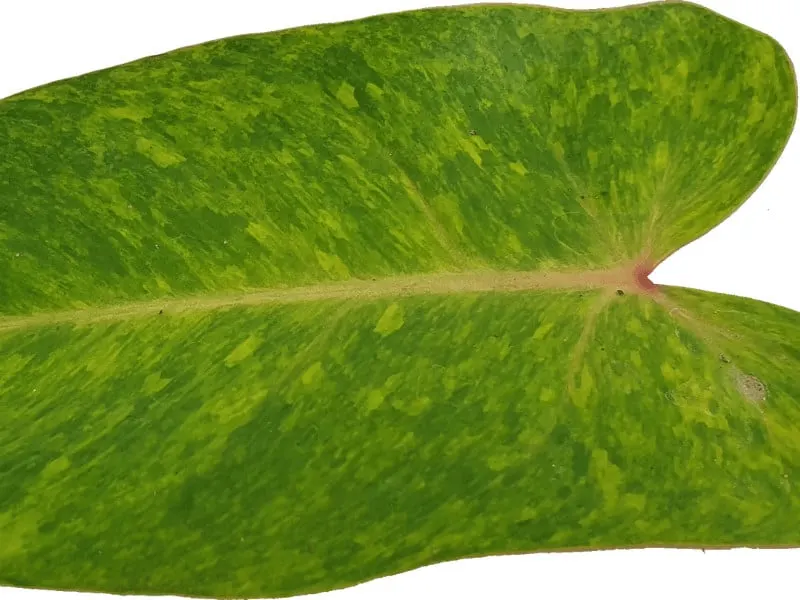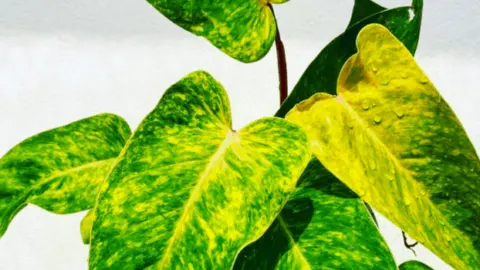This article is about Philodendron Painted Lady care and plant information.
Philodendron Painted Lady
Philodendron Painted Lady or Philodendron erubescens ‘Painted Lady’ by is correct botanical name, is a variegated climbing Philodendron.
According to the University of Florida, Philodendron Painted Lady is a hybrid between Philodendron erubescens Burgundy and Philodendron Erubescens Emerald Queen.
The Philodendron family belongs to the Araceae or Aroid genus.
The word Philo means ‘love’ and Dendron means ‘tree’ in the Greek language. For this reason, Philodendrons are considered tree huggers and grow well with support.

Takeaways
| Species | Pilea mollis |
| Synonyms | Friendship Plant, Pilea, Moon Valley Plant |
| Family | Urticaceae |
| Genus | Pilea |
| Growth | Compact, spreading |
| Height | 1.0 inch |
| Width | 1.0 inch |
| Soil | Well-draining soil mix |
| Watering | Every 7-14 days |
| Light | Bright indirect |
| Temperature | 65.0°F - 80.0°F (18.3°C - 26.7°C) |
| Humidity | 40.0% - 60.0% |
| Fertilizer | 1.0 |
| Propagation | Stem cuttings, division |
| Toxicity | Non-toxic to cats, dogs, or humans |
Philodendron Painted Lady Care
Philodendron Painted Lady prefers dry soil conditions. Choose a well-draining potting soil and allow your plant to dry out between watering.

Table of Contents
What Soil is best for Philodendron Painted Lady?
A rich, moist soil mixture works great for a Painted Lady Philodendron. Consider planting it in a well-draining cactus or succulent mix (partly sand). Just make sure whatever potting medium you choose is lightweight.
In mild climates, you can grow it outdoors. The ideal USDA hardiness zones for outdoor planting are 9b-11. You can grow it on a patio in USDA hardiness zones 4a – 11.
For growing it in a container or pot, you can use a regular potting mix with sand. Adding sand will help improve drainage. The ideal soil pH is 6.1 – 7.3, slightly acidic to neutral.
How often to water a Philodendron ‘Painted Lady’?
The Philodendron Painted Lady prefers to stay on the drier side. Allow the plant to dry well between watering sessions. This plant needs frequent watering, but Philodendron growers highly discourage keeping this plant wet or standing in water.
Water it using the soak-and-dry method. This is done by watering your plant thoroughly and then allowing it to dry out completely before watering again. Closely monitor the moisture levels using your fingers or a moisture meter.
If you water your Painted Lady plant too often, it will probably not survive. Philodendron species can go for weeks without water, so skip watering if you are unsure whether your plant needs water.
The Painted Lady plant is sensitive to both over and under-watering. Therefore it is important to experiment and understand the watering requirements to help your Philodendron plant grow well.
Generally, you can water every 7-9 days in the summer and every 2-3 weeks in the winter.
Philodendron Painted Lady Light
Philodendron Painted Lady requires 70-85% sun. It will thrive well in bright, indirect sunlight.
Keep it in a well-lit room with adequate sunlight. Place the Painted Lady plant near the window where the direct sunlight cannot hit the foliage. This plant can happily survive in medium light and partial shade.
Protect the Philodendron Painted Lady from prolonged sun exposure; else, the foliage will start browning. Too much sunlight causes yellowing of foliage, whereas too little lighting will make the stems leggy.
For outdoor locations, use a shade cloth to protect your plant from direct sunlight.
What is the optimal Temperature for a Painted Lady?
The optimum temperature range for a P. Painted Lady is around 64.0°F (17.8°C) – 77.0°F (25.0°C).
In mild climates, you can grow it outdoors. The ideal USDA hardiness zones for outdoor planting are 9b-11. You can grow it on a patio in USDA hardiness zones 4a – 11.
The Painted Lady plant is not temperature tolerant. It cannot withstand extreme temperatures. It is sensitive to cold environments.
Move your outdoor plant inside as soon as the weather starts getting chilly.
Indoors, the Philodendron Painted Lady, should not be placed next to fans, air conditioners, or vents.
Philodendron erubescens ‘Painted Lady’ Humidity
Philodendron Painted Lady prefers 65-80% humidity.
You can use a humidifier to improve the indoor humidity level.
Occasionally mist the leaves with water on warm and windy days during spring and summer. But don’t allow the water to sit on foliage because this increases the risk of diseases and pest infections.
How to fertilize a P. Painted Lady
Fertilize using an all-purpose foliage fertilizer for the Philodendron Painted Lady every 2 weeks in the active growth season, spring and summer.
Use a liquid quick-release fertilizer to provide the necessary nutrients.
You can also fertilize the newly planted Painted Lady three times per year using a slow release fertilizer. Make sure you are fertilizing 6 inches away from the base (15 cm).
This plant does not need much food in winter, feeding once a month is enough. Overfeeding will damage and kill the plant roots.
Repotting a Philo Painted Lady
The Philodendron Painted Lady has a well-established and robust root system. This slow-growing plant will not require repotting at least for 2 or 3 years. You can repot anytime in the growing seasons if it’s outgrowing the pot.
Move it to a slightly bigger pot (one size bigger than the previous one) and resume the usual planting care. This plant needs looser roots instead of being pot bound, that’s how it’s going to get tall and healthy.
Pruning
You can maintain this plant’s appearance by trimming any excess growth. However, avoid over-pruning, it can reduce the overall growth of the plant.
Philodendron Painted Lady Propagation
Philodendron plants are considered the easiest to propagate. Propagation is a great way to multiply your houseplants without spending any money. Always use clean, sterilized scissors or blades when trimming or cutting your plants.
Water Propagation:
- Choose a mature and healthy plant for propagation. Take stems-cuttings of 4-6 inches above an existing leaf joint in the growing season.
- It is important to identify the location where you will make a cut on your plant; ideally, it should be ¼” below the node. Pinch off two to three lower leaves from the cutting so that you have some bare leaf nodes. Now let the cuttings dry for a few hours.
- You can place this cutting in a jar of water, vermiculite, perlite, or soil.
- For water propagation, fill a glass jar with water leaving 1-inch space at the top. I suggest leaving the water to sit overnight; this will dissipate chlorine. This will also bring the water to room temperature because using too cold or hot water can shock the plant leading to a failed propagation.
- Submerge the leafless nodes in water, ensure that the remaining upper leaves are not touching the water.
- Refresh the water after 2 to 3 days using room temperature water and place the cutting in bright, filtered sunlight during the rooting phase. You can add sheer curtains to windows for diffusing the sunlight.
- Direct sunlight can also encourage algae growth in water propagation.
- When changing water, gently rub the roots with your fingers to wipe away the dirt. I really enjoy propagating my plants in water because that way, I get to watch the root development.
- The cutting will start rooting in 10 to 20 days. Once the roots are 3 to 5 inches (7.5-10cm), your cutting can be transferred to soil. The longer you keep the cutting in water, the more difficult it becomes for the plant to acclimate to the soil.
- This plant will take some time to establish itself. Follow the care instructions mentioned above to help it grow.
- You have to be patient with water propagation because the cuttings may not show any signs of root development for about 2 weeks.
Air Layering:
This is the most interesting propagation method because it allows you to propagate a plant before you take any cuttings from the mother plant. Keep reading to learn how:
- All you need is sphagnum moss and a healthy Painted Lady Philodendron. Choose a healthy stem and wrap the moss around the node and the support. Wrapping around the support is optional, but it secures the moss better.
- It is better to soak the sphagnum moss in water for 1 hour before starting the air layering. The moisture on the moss will create a humid environment that encourages growth.
- You can use regular plastic sheets to wrap; you’ll end up with a wrapped moss ball.
- Don’t wrap any leaves because they will rot. Keep a small opening while wrapping for air circulation.
- This approach for air layering is the safest because even if the propagation fails, you haven’t taken the cutting, so you are not losing anything.
- Spray the moss ball every day to keep the moss moist. Roots will start appearing in 2 to 3 weeks.
- Open the wrapping and gently remove some moss around the roots. Now take stem cuttings by cutting just below the node. Choose a spot so the final cutting will have at least two leaves.
- Place the cutting in a transparent plastic cup and add fresh sphagnum moss. Follow the care instructions mentioned above for the Philodendron Painted Lady.
Philodendron Painted Lady Flowering
The inflorescense consist of a spate and spadix. The inflo is green, cream, and white when it does. The blooming season is late spring to mid-summer.
These flowers smell unpleasant and waste the plant’s energy and nutrients. Therefore most growers remove them as soon as they grow.
Philodendron Painted Lady Growth
Philodendron Painted Lady a self-heading plant; it grows upright and spreads outwards. The leaves are glossy and smooth-edged. Young leaves begin neon yellow, and leaves fade to a deeper green with scars and spots as the plant matures. The plant retains the bright pink color of the stems through maturity.
The large, heart-shaped leaves are the most appealing aspect and the selling point of the Philodendron Painted Lady. The leaves are glossy and textured and, on a mature plant, are about 6 inches in size.
This is a slow-growing plant, but a mature plant can easily reach a height of 2 to 5 ft with support. And can be between 12 to 16 inches in width.
The growth rate for this Philodendron plant varies depending on temperature, light, and soil type. It takes about 5 years to reach maturity.
Philodendron Painted Lady Dormancy
Like many other houseplants, this one also goes into a dormant or resting phase during the winter. The plant will automatically stop growing to conserve food and water. You don’t have to bother the plant during this phase, just let it be; it will get normal when spring arrives.
Common Problems for Philodendron Painted Lady
This plant is a no-fuss plant with little pest or disease issues. Some of the possible problems are discussed below.
Mealybugs: These are common houseplant pests. They feed on the plant nutrients by sucking the sap. Neem oil is the most organic solution for treating mealybugs. You can even wipe the leaves with rubbing alcohol.
Spider Mites: Keep the stems and leaves dry because moist foliage attracts pests like spider mites. Spray your plant with insecticide or soap water to kill the mites. These mites also feed on the plant’s sap.
Yellowing or Wilting leaves: Overwatering, soggy soil, and inadequate soil drainage are the main reasons for yellow and wilting leaves on Philodendron Painted Lady. All these cause the roots to suffocate. You can easily solve these issues by watering the plant only when the soil feels dry and ensuring proper drainage by choosing a container with at least one drainage hole.
Brown Spots: Your plant will start having brown spots or patches when exposed to direct sunlight for too long. The leaves will also have a pale and dry appearance due to sunburns. Immediately move your plant to a shadier place and see how it performs.
Bacterial leaf spot diseases: The main symptoms include brown spots with yellow halos, dark areas on the leaf, and black-eyed lesions. The leaves become very delicate and papery with crispy brown edges.
Leaf spot diseases mostly affect the older leaves but can also damage the new, young leaves. Stop overhead watering to prevent the spread of these bacterial diseases. Remove the affected leaves and apply a copper fungicide.
Bacterial Blight: If your plant is rapidly developing small dark green spots, it is affected by bacterial blight. The leaves will start dropping, and the plant has a foul smell. The first step is to stop overhead watering. Water your plant in such a way that the leaves and stems are dry.
Tip curl: Overfertilization will cause the leaf tip to curl downwards and turn brown. Tip curling can be avoided by reducing the fertilization rate. If you were using a slow-release fertilizer, flush the soil with water. You can also consider repotting in new soil if you believe some fertilizer is still left.
Tips for growing Philodendron Painted Lady
- Do not overwater or overfeed the Philodendron Painted Lady; this will inhibit its growth.
- When watering this plant, use lukewarm water to prevent any temperature shocks.
- The large leaves can collect dust particles, and clean them regularly to prevent pests or infections.
- Never water the plant if the soil is still wet; this will waterlog the soil and cause many problems. The growth rate will decrease, and the plant may even die.
- The potting mixture should be chunky to promote air circulation for the roots.
Philodendron erubescens Varieties
Some popular Philodendron erubescens varieties are:
- Philodendron erubescens
- Philodendron erubescens ‘Pink Princess’
- Philodendron erubescens ‘Burgundy’
- Philodendron erubescens ‘Imperial Red’
FAQ
What is the best way to support the Philodendron Painted Lady?
This plant grows well when provided with support. You can use a mossy post or burlap pole to help it climb upwards. It will produce large leaves with vertical support.
What is the toxicity level of this Philodendron Plant?
This plant is highly toxic. The calcium oxalate crystals can cause skin and eye irritation. It can also cause swelling, inflammation, and pain in the case of swallowing. Keep it at a location away from the reach of children and pets.
What are the different ways to display this plant?
This bushy plant looks beautiful in hanging baskets. You can also create a tropical accent of green wall by growing it next to a wall. Painted Lady has light green leaves; when paired with other dark-colored plants, it can create a great display of green. Balconies and sunrooms are also perfect locations for this plant.
What other plant species can be grown together with a Philodendron?
Pothos and Monsteras are closely related to Philodendrons in terms of their plant care. All these belong to the Araceae plant family, their leaf shapes and colors create a beautiful display when grown together.
Conclusion
The shiny green foliage makes this plant stand out among others. With a yellowish tint and speckles, the leaf’s color range in shades of light to dark green.
It has pink petiole, stems, and spade-shaped leaves. If you want to maintain the yellow variegation of the young plants, increase the light exposure for the Painted Lady. This evergreen plant will reward you with unique textured leaves for as long as it lives.
The best thing is that even an amateur plant grower can successfully keep a Philodendron Painted Lady alive and well.

Daniel has been a plant enthusiast for over 20 years. He owns hundreds of houseplants and prepares for the chili growing seasons yearly with great anticipation. His favorite plants are plant species in the Araceae family, such as Monstera, Philodendron, and Anthurium. He also loves gardening and is growing hot peppers, tomatoes, and many more vegetables.


